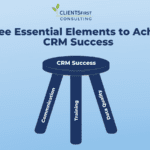12 Reports to Enhance CRM Adoption and ROI

For many professional services firms, finding ways to demonstrate CRM value and encourage adoption is a constant struggle. System usage is rarely mandated, which means the marketing team is put in the difficult position of trying to convince individual professionals that there really is value in entering information into the CRM system themselves or getting their assistants or the Marketing/Business Development staff to help with the input.
In effect, this means that the Marketing and CRM teams are constantly being reactionary in trying to chase down information that ideally should have been entered proactively. At the same time, and paradoxically, the same professionals who balk at taking the time to input or share their data frequently request analytics or dashboards of information from the system to assist with business development.
If this all sounds familiar, here are some suggested reports that you can – and should – develop and circulate regularly to encourage the sharing of information and provide value to your users, which can encourage increased adoption and sharing in the future.
- Key Relationships: It’s a common occurrence that professionals think they are the only ones who may know a particular person. In the past, this has made some of them protective of their relationships and/or hesitant to share them in the CRM system. But in reality, when their relationships are shared, they are often shocked to see how many others in the firm know the same people. In addition, when they are trying to develop business with a prospect, a who knows who report that highlights a key connection in the firm is invaluable and can increase collaboration and the sharing of additional contact and relationship information.
- Bounces: Email bounce reports are real-time data quality indicators that are vastly underutilized. Email marketing systems will automatically stop sending to email addresses that have “hard bounced” – meaning the email address is no longer valid or has had a given number of consecutive “soft” bounces which typically happen for temporary reasons such as the mailbox being full. While this is great for preserving your firm’s email sender reputation and helps to protect your domain from being blacklisted, it is important to also research and update those records or remove them from your system. Regularly circulating bounced email reports to professionals can give them valuable information about contacts who may have changed companies or locations and may also prompt them to update those records or even reach out to the individuals.
- Preference and Sign-up Form Submissions: There are two main reasons why you should be looking at your preference and sign-up form submissions. The first is to keep abreast of your contacts’ interests for business development purposes. For example, if you have a mailing list or area of interest that has grown in popularity over time, then it is important to regularly generate content for that list. Second, it is important to review new sign-ups to look for inappropriate submissions from individuals who should not be on the list or that may have been generated by malware attempting to infiltrate your system. Using a CAPTCHA (Completely Automated Turing test to tell Computers and Humans Apart) can assist with preventing malware issues but is not a substitute for regularly reviewing lists.
- Newly Added Companies: Regularly reviewing which company records have been added to the CRM system over a certain timeframe can be another useful tool for business development purposes as well as ensuring that new client companies are making it into the system.
- Newly Added Contacts: Similar to reviewing new companies, newly added contacts should also be reviewed to ensure that you’re capturing the influencers and decision-makers at key companies.
- Company Changes: Circulating reports of changes to company records is another way to provide your users with value by letting them know that a company has moved, been acquired or gone out of business.
- Email Metrics Reports (click-throughs): While your professionals may be enthusiastic about generating content, often they don’t bother to ask who has actually read that content. Clickthrough reports are the most accurate way to reveal which contacts are actually interested in your publications and can provide invaluable business development information. These reports are also useful when trying to encourage professionals to write more or to adopt a different style. For example, circulating quarterly clickthrough rates by practice is a great way to appeal to your professionals’ sense of competition with one another.
- Alumni Changes: Even if you don’t have a formal alumni program, it is always a good idea to keep track of your former employees for business development purposes. If a former associate is now general counsel at a company your firm has targeted as a key prospect, you probably already have a leg up on the competition – as long as this information makes it into the right hands.
- BD Activities: Most firms struggle with getting information from their professionals on who they are meeting and interacting with – whether for formal pitches or just a conversation over coffee. This is another area where circulating reports of the known activities will almost certainly result in additional submissions by professionals who realize that their meetings are not included in the report.
- Speaking Engagements/Conferences: Another common complaint we hear from marketers is that they are not informed when professionals are attending a conference or participating in an event. Publicly circulating known engagements encourages other firm participants to add theirs in as well. After all, they want credit too!
- New Clients/New Matters: While some firms in the past may not have embraced transparency for cultural reasons, more and more we are seeing firms wanting to end those traditions because they hinder collaboration and can hurt the bottom line. In firms where cross-selling has become a priority, circulating a new client report is an easy way to encourage cross-practice collaboration.
- Metrics by Practice: Professional services firms are usually staffed by driven, competitive personalities. For this reason, marketers have been increasingly relying on “gamification” tactics to encourage participation in business development and CRM initiatives. Calculating and circulating cumulative reports by practice area is a great way to achieve this. If you have one or two practices that are adept at producing captivating content and are trying to encourage that same productivity in other practices, a tally sheet of metrics can be a great motivator.
While generating reports from CRM data is a relatively easy thing to do, marketers are sometimes leery of this approach to encourage adoption out of fear that it will have the opposite result – we don’t want to call attention to the lack of important information in the system. But in reality, professionals are much more likely to add in their information when they (and everyone else) can clearly see that it is missing and could be beneficial. So, developing clear, concise and well organized reports can actually result in an influx of previously undiscovered data – and can drive system adoption and value.
For more than a decade, the team at CLIENTSFirst Consulting has been helping professional services firms and other organizations successfully select and implement CRM and eMarketing systems to maximize value, adoption and return on investment. If you need help achieving CRM Success, please contact us at 404-249-9914 or Info@ClientsFirstConsulting.com.






